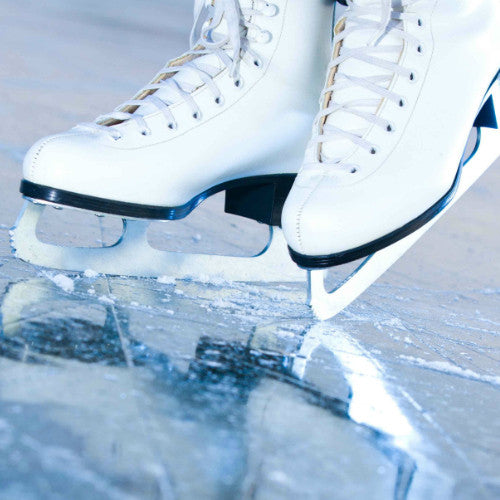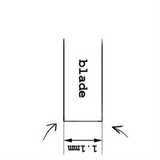Answered on Quora: Ice Blades

This was asked on Quora: Why do you sharpen ice skates?
In a nutshell, to keep ice-skating enjoyable. Dull skates are not fun.
For the skater athlete, it’s also about optimising performance.
Contrary to the armchair ice-skater’s belief about ice-skating, it isn’t all slippy and slidey…it’s actually grippy!
How?
The ice blade itself is the ultimate connection between the boot and the ice. The smoother the edge along the blade, the more potential for a secure grip on the ice especially when the blade itself is at an angle to the ice.
If the blade hasn’t been sharpened and has lots of little nicks, or another phenomena called ‘burring’, the opportunity for the ice blade to grip the ice surface is reduced, making the skates feel like they have a mind of their own. Those who use hire rental skates often have this experience. The motivation and time for sharpening skates may be overlooked in a busy rink situation. Also, the hirer may accidently walk on surfaces that are not friendly to the metal blade such as concrete or other metals.
Now, for the non-ice skaters, here’s an insight into ice blades. They have not one, but TWO edges! They are not like a kitchen knife blade that has one edge for the purpose of cutting. (Imagine the horror that one figure skater experienced when she took her boots to a shoe repairer and he decided that there was something ‘wrong’ with her blades and decided to sharpen them to a knife edge. Ouch!)
To add to this, hockey and figure skate blades are very different from a speed skate blade and are sharpened very differently.


The first diagram is of a hockey or figure skate blade, if you were facing the blade from the front or back. You can see a concave bottom to the blade. This maximises the potential grip of the blade because it increases the surface area that digs into the ice. This is necessary for the quick changes in direction in hockey or ensuring a safe landing for those figures skaters who do jumps and spins in the air. Also, the blade is quite short. Not finding the sweet spot on a landing and having skates that need sharpening means a possible tumble in a figure skating event.
Hockey and figure blades need to be sharpened on a special machine that has a rotating stone that shapes the concave into the blade. A basic machine is thousands of dollars to purchase, so the blades are generally entrusted to a rink or a shop. As a skater becomes proficient at the sport, they tend to know who can sharpen their blades the same way each time, as this is a craft that comes with time, experience and enthusiasm. If you have a favourite barista, it’s the same sort of relationship!
The second diagram is a speed blade from the same aspect. You can see quite clearly that there are still two edges, however, it has a flat bottom. The blade is a lot longer than a figure or hockey blade and does not need the extra grip that a concave bottom does; the flat edge on the bottom enhances the glide when the skater brings the blade onto that edge. Because the blade is warmer than the ice, it melts the ice ever so slightly creating a frictionless layer of water underneath it adding the potential of the skater going as fast as possible.
In speed skating, the skater does between 2 to 4 crossovers at each end and a push from each leg down the straight. This means the skater is only on flat edge twice in one lap. ( if they are experienced and not child aged who still have to do a couple of pushes down the straight). It takes remarkable skill to be balanced on this one edge as it can have a sensation of being out of one’s control. Also, only experiencing twice in one lap means that it takes a long time to experience this and be comfortable with. Watch a speed skating training session and you will see drills being done to hone this skill, which are done at quite slow speed to really nail it.
These blades are sharpened via a completely different method and involve placing the skates into a jig that holds them so the flat side of the blade is facing up. Then a series of rectangular shaped flat stones from course to smooth are used to create a perfect 90-degree angle. The person doing the sharpening sits on the floor with the jig between their knees and gently ‘scrubs’ the flat side of the stone along the length of the upturned blades. Using the stones causes the blade to ‘mushroom’ out along the whole length of the blade. As this is quite fine, a smaller stone is then run along the whole flat side of the blade on both sides to remove the burr. The method for testing if there is a burr is by running a thumbnail up the blade towards the edge. It’s crude, but very effective. If there is a burr. the nail ‘trips’ over it which signifies that it is time to de-burr.. Then the next stone can be used to hone the edge to that perfect 90-degree shape and add a mirror like shine to that bottom edge. A jig and stones are easily affordable and portable for skaters. This means that most skaters sharpen their own blades and can learn this skill at a young age. The ultimate test of having a sharp blade is then tested using the thumbnail method. This time, the thumbnail is aimed at the blade edge and gently tapped along the edge. A sharp blade will produce small filings that are visible along the edge of the blade. In years of sharpening short track ice blades and being a nail polish wearer, I would sometimes have to time the sharpening with nails that are between a varnish. Feeling for a burr wasn’t compromised by nail varnish.
Factors that affect how long the blades stay sharp for both types of blades:
(1). The quality of the blade. You simply get what you pay for. A lower priced blade needs sharpening more often and takes longer to achieve. It will also lose it’s edge’s very quickly.
(2). The quality of the ice. Some ice rinks have a base of sand before an ice surface is created. When the ice becomes a touch thin or damaged, this sand layer can creep into the ice itself. Sand and ice blades do not mix well. Other things that appear on ice rinks are lolly wrappers, tissues and other soft material items seem to make their way out of people's pockets. While not particularly damaging, they can increase the chance of a skater having a fall, which can lead to clashes with other skater’s blades. The scariest item to encounter is the humble hair bobby pin, which seem to appear in droves after a figure skating competition! I lost an earring once at the ice rink at a general session and was horrified that it may have ended up on the ice itself. It was never found and I hope never to hear a story from someone coming to mischief about hitting a pink sparkly earring.
(3). How they skater treats their ice blades. When you watch the Olympics, you will see skaters gently ‘walk’ onto the ice and remove the plastic guard they have protected their blade with after a previous competition or training session.
(4). The weight of the skater. A big heavy burly man places more load on the edges than a petite, lady skater.
(5). Hockey stopping. While fun to do and are spectacular at spraying ice at your mates, they impact the edges that take the brunt of the slide..ie: the edges that are facing the direction of travel. Hockey stopping is not recommended to do on the short track blades, but they are oh so fun to do!
(6). Crashes. Impacting others skater’s blades can strip and edge, or even break the whole blade. Short track speed skaters always have a spare set of blades with them when travelling to competitions for exactly this reason. (And ideally, have spare laces and buckles in their kit.)
(7). Drying them after each session. Once off the ice, the blades are given a wipe down with a hand towel. Some skaters carry a set of ‘soakers’ to place on their blades before they leave the rink. Once home, they are removed and the blades are exposed to the air to ensure they dry completely. This reduces chances of surface rust spots to appear which can impact the edges if in that region of the blade. Further up the blade, it is more cosmetic but screams “I do not care about my blades” to other skaters or the coach.
(8). The intensity of the activity. Many short track coaches that mostly stand on the ice surface have not sharpened their skates in years because they simply don’t need to but may have the added responsibility of sharpening blades of junior skaters. A racer at the Olympic level will sharpen their blades after every race.
So, there you have it. It is an overview. For a sport that looks so simple (especially short track as it appears that the skater just skates ‘ in circles’), it is complex at the equipment level.
Oh, did I mention that in all 3 disciplines, the blade is also curved along the length of them when looked at side on? To add to this, short track speed blades have a slight left facing curve along the length of them. All in the name of maximising grip on the ice! Perhaps that can be a future essay.
Andrea
Here is a 9-minute movie of Andrea sharpening some speed blades..
